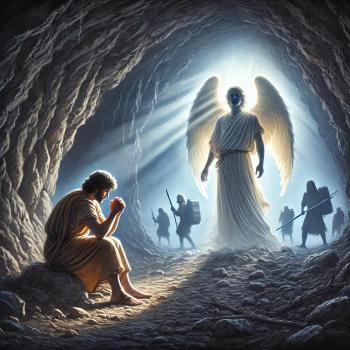Revelation 6:1-8 The Four Horsemen
As we begin chapter 6, we start to see the unfolding of God’s judgment in history. World history begins its end with the seven seals in this chapter. The future timeline now begins to open the scroll by breaking the seals. (This initiates three sets of judgments in Revelation 6–16: seals, trumpets, and bowls, with each using a four-three pattern.)1 This four-three pattern is how we will address each of the sets of judgments. I want focus on the first four seals and then next week, we will look at the last three seals. These first four seals are commonly known as the “Four Horseman.”
These first four seals function as “preliminary judgments representing forces operative throughout history” that serve God’s sovereign purposes and usher in the events of the end of the age.12 The evidence suggests that these disasters run simultaneously throughout history rather than one after another in a severe trial right before Christ returns.23
God is still a God of love. He delegates His work of judgment to other people. In this case, these acts of judgments are carried out by the four living creature.
In fact, it might even be observed that while the seal judgments are less specifically associated with God, the trumpet judgments bear more of the actual mark of heaven since these are trumpets sounded by seven angels. The seven thunders seem to be even more associated with God, even though their message remains hidden, and the seven bowls of God’s wrath are specifically associated with “the wrath of God.”4
THE FOUR HORSEMEN
The first four seals are commonly known as the “four horsemen” of the Apocalypse. There are various interpretations about the timing of the release of these horsemen. Some say that when the first one is released, the tribulation period – the 70th week of the book of Daniel – will commence. This the reason why the word “Come” is said to each one. Others believe that these four horsemen have continued through time and will continue and increase in intensity until the tribulation period begins.
“Then I saw the Lamb open one of the seven seals, and I heard one of the four living creatures say with a voice like thunder, “Come!”” (Revelation 6:1, HCSB)
The word “Come” means “to arrive,” “to approach,” or “to be going.” God allows each of the four living creatures to send out these horsemen. A different living creature in Heaven releases a corresponding horseman on Earth. We don’t know which living creature is connected to which horseman. Yet it clear that God commands on Heaven corresponds with what takes place on Earth.
As a result, these horseman are indirectly sent by God to fulfill His purposes. Warren Wiersbe explains that: “Horses represent God’s activity on earth, the forces He uses to accomplish His divine purposes. The center of His program is Israel, particularly the city of Jerusalem.5 The imagery is primarily being lifted from Zechariah 1:8 and Zechariah 6:2-6.
1. Antichrist (Revelation 6:1-2)
The first horseman rides a white horse.
“Then I saw the Lamb open one of the seven seals, and I heard one of the four living creatures say with a voice like thunder, “Come!” I looked, and there was a white horse. The horseman on it had a bow; a crown was given to him, and he went out as a victor to conquer.” (Revelation 6:1–2, HCSB)
There are two people in this book who ride a white horse. The first person is here. The second person is in Revelation 19. In Revelation 19, we will see a Man on a white horse, who is clearly the Son of Man, Jesus Christ. But we know by the company he keeps that the man on the white horse here in chapter 6 is not Jesus.6 Craig Keener makes the claim that “the evidence is not clear enough to support a connection with Gog”.7
I disagree. I make the claim that the rider of the white horse from the first seal judgment here in Revelation 6:1-2 is the same as the “Beast out of the sea” in Revelation 13, a.k.a. “Gog of Magog” of Ezekiel 38 and Revelation 20, a.k.a. the Assyrian from Micah 5, a.k.a. the “Man of Intrigue” in Daniel 8, a.k.a. the “Man of Sin” in 2 Thessalonians 2. These passages describe the same person, known as the Antichrist.
And he has a bow, but not a bow and arrow. The Greek word for bow used here is only used one other place: it is a token of a covenant.
“Whoever sheds man’s blood, his blood will be shed by man, for God made man in His image.” (Genesis 9:6, HCSB)
The bow here could be the token of the very covenant which defines the Seventieth Week of Daniel.8
“He will make a firm covenant with many for one week, but in the middle of the week he will put a stop to sacrifice and offering. And the abomination of desolation will be on a wing of the temple until the decreed destruction is poured out on the desolator.”” (Daniel 9:27, HCSB)
What are the differences that show that this horseman is different from the One in Revelation 19? How are these two different people? Look at the differences between these two men:
“I looked, and there was a white horse. The horseman on it had a bow; a crown was given to him, and he went out as a victor to conquer.” (Revelation 6:2, HCSB)
“Then I saw heaven opened, and there was a white horse. Its rider is called Faithful and True, and He judges and makes war in righteousness. His eyes were like a fiery flame, and many crowns were on His head. He had a name written that no one knows except Himself.” (Revelation 19:11–12, HCSB)
CONTRASTS BETWEEN THE RIDERS ON THE WHITE HORSE IN REVELATION
Item Revelation 6:2 Revelation 19:11-12
Rider Antichrist Christ
Location Earth Heaven
Crown Stephanos Diadem
Weapon Bow Sword
Purpose Conquer the Earth Judge the Earth
THE WHITE HORSE AS SEPARATE FROM THE OTHER THREE
Although most scholars insist that the four riders should be treated as a set,9 there are grounds for regarding the white horse as distinct from the others. Firstly, it comes first, a position that it never has in Zechariah. Secondly, the other three riders represent the elements of an existing threefold structure of woes which may be traced to Jeremiah 14:12 and 21:9 where sword, famine and pestilence are mentioned.
“If they fast, I will not hear their cry of despair. If they offer burnt offering and grain offering, I will not accept them. Rather, I will finish them off by sword, famine, and plague.”” (Jeremiah 14:12, HCSB)
“Whoever stays in this city will die by the sword, famine, and plague, but whoever goes out and surrenders to the Chaldeans who are besieging you will live and will retain his life like the spoils of war.” (Jeremiah 21:9, HCSB)
Then, the first is unlike the rest in that it offers no physical harm or danger. Next, the power of the last three is clearly limited but that of the first is not. Finally, the consequences of the last three horses appear to be summarized at 6:8 while no reference is made to those of the first.10
The first horseman is followed by the second one.
2. War (Revelation 6:3-4)
“When He opened the second seal, I heard the second living creature say, “Come!”” (Revelation 6:3, HCSB)
A second living creature (still unnamed) releases a second horseman.
“Then another horse went out, a fiery red one, and its horseman was empowered to take peace from the earth, so that people would slaughter one another. And a large sword was given to him.” (Revelation 6:4, HCSB)
The second horseman rides a fiery red horse. The imagery recalls a war-like environment. War follows politics. Political leaders engage in war.
3. Famine (Revelation 6:5-6)
“When He opened the third seal, I heard the third living creature say, “Come!” And I looked, and there was a black horse. The horseman on it had a set of scales in his hand.” (Revelation 6:5, HCSB)
The third horseman rides a black horse. Just as war follows politics. Famine follows war. Famine can come from either a shortage of resources by war. Famine can also come by political manipulation. Political forces can cause inflation, which can lead to famine. Most famines are not caused by a shortage of resources, but by political manipulation.)11
“Then I heard something like a voice among the four living creatures say, “A quart of wheat for a denarius, and three quarts of barley for a denarius —but do not harm the olive oil and the wine.”” (Revelation 6:6, HCSB)
A denarius is a Roman silver coin equivalent to a day’s wage of a common laborer.12 A full day’s wage will only buy a little wheat or barley because of Antichrist’s system that is based on the mark of the beast.13 The olive oil and wine represents luxury. The poor suffer increasing poverty. The rich will get richer. We are starting to see that process happen now. The 1% versus the 99%. The standard of living in the United States, while still rich, is harder to maintain. Our national debt continues to climb. As a nation, the government is still using a credit card with a debt so high that we can’t eventually pay it off. Globally, there are so many countries who are in debt, that there will be a major economic collapse. This economic spiral will continue to get worse until the rise of a world leader.
4. Death (Revelation 6:7-8)
“When He opened the fourth seal, I heard the voice of the fourth living creature say, “Come!”” (Revelation 6:7, HCSB)
The four horseman rides a pale green horse.
“And I looked, and there was a pale green horse. The horseman on it was named Death, and Hades was following after him. Authority was given to them over a fourth of the earth, to kill by the sword, by famine, by plague, and by the wild animals of the earth.” (Revelation 6:8, HCSB)
Chloros, the Greek word translated “pale,” is the same word from which we get the word “chlorine”—or bleached—and “chlorophyll”—or green. In other words, this horse is really ugly.
In what follows, the world desires peace, but finds war; it works for prosperity, but it finds scarcity; it seeks life, but finds only death.14 The beasts of the earth that cause death are not necessarily four-footed animals. Chuck Missler states that “They might be beasts you see under a microscope. They could even be some biological pestilence being cultivated as a terrorist weapon.”15
Death parades on his horse and the realm of the departed follows like a street sweeper behind him, cleaning up the debris of the fallen and imprisoning them in that shadowy world.16 Hades is the place of the dead. Hades is not hell. Hell is the final place of eternal punishment that happens after death.
War follows politics. Famines follows war. Death follows famine. One can see that all of these forces can influence one another. Each of these forces can also increase in intensity. Death is caused by war, famine, and disease. As a result, death increases in intensity.
Jon Courson notes the following contrasts:
Each of the three preceding horsemen appeared in disguise. Deception appeared as a peacemaker on a white horse; war as patriotism on a red horse; famine as luxury on a black horse. And this fourth horseman is no exception, for what does it say about a culture like ours whose number one industry is health care?
“We’re so advanced!” we think.
No, we’re sick!17
God has allowed human wickedness to do its destructive work, resulting in judgment through warfare, bloodshed, famine, disease, and death. But again, we see a measure of restraint in that only one-fourth are affected.18
1 J. Scott Duvall, Revelation, ed. Mark L. Strauss and John H. Walton, Teach the Text Commentary Series (Grand Rapids, MI: Baker Books, 2014), 100.
21 Mounce, Revelation, 139.
2 Beale, Revelation, 370–71.
3 J. Scott Duvall, Revelation, ed. Mark L. Strauss and John H. Walton, Teach the Text Commentary Series (Grand Rapids, MI: Baker Books, 2014), 100.
4 Paige Patterson, Revelation, ed. E. Ray Clendenen, vol. 39, The New American Commentary (Nashville, TN: B&H, 2012), 177.
5 Warren W. Wiersbe, The Bible Exposition Commentary, vol. 2 (Wheaton, IL: Victor Books, 1996), 587.
6 Jon Courson, Jon Courson’s Application Commentary (Nashville, TN: Thomas Nelson, 2003), 1703.
7 Craig S. Keener, Revelation, The NIV Application Commentary (Grand Rapids, MI: Zondervan Publishing House, 1999), 201.
8 Chuck Missler, Learn the Bible in 24 Hours® (Nashville: Thomas Nelson, 2002).
9 Caird is particularly insistent about this. 1984.80–81.
10 Stephen Finamore, God, Order, and Chaos: René Girard and the Apocalypse (Milton Keynes: Paternoster, 2009), 196–197.
11 Chuck Missler, Learn the Bible in 24 Hours® (Nashville: Thomas Nelson, 2002).
12 Johannes P. Louw and Eugene Albert Nida, Greek-English Lexicon of the New Testament: Based on Semantic Domains (New York: United Bible Societies, 1996), 61.
13 Jon Courson, Jon Courson’s Application Commentary (Nashville, TN: Thomas Nelson, 2003), 1704.
14 Robert W. Wall, Revelation, Understanding the Bible Commentary Series (Grand Rapids, MI: Baker Books, 2011), 109.
15 Chuck Missler, Learn the Bible in 24 Hours® (Nashville: Thomas Nelson, 2002).
16 Paige Patterson, Revelation, ed. E. Ray Clendenen, vol. 39, The New American Commentary (Nashville, TN: B&H, 2012), 182.
17 Jon Courson, Jon Courson’s Application Commentary (Nashville, TN: Thomas Nelson, 2003), 1705.
18 J. Scott Duvall, Revelation, ed. Mark L. Strauss and John H. Walton, Teach the Text Commentary Series (Grand Rapids, MI: Baker Books, 2014), 102–103.












